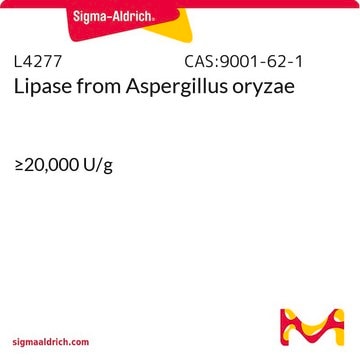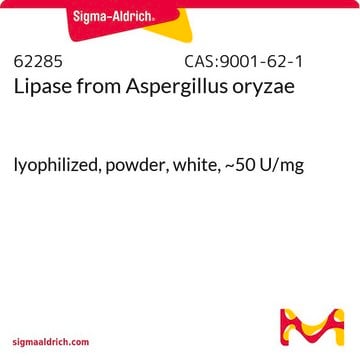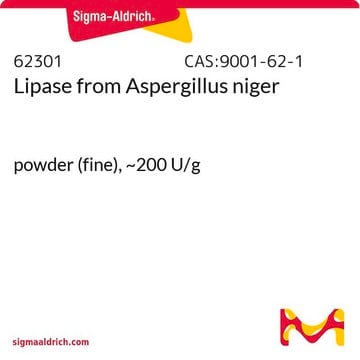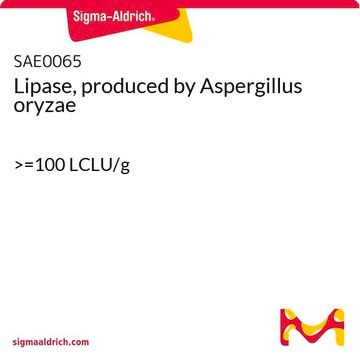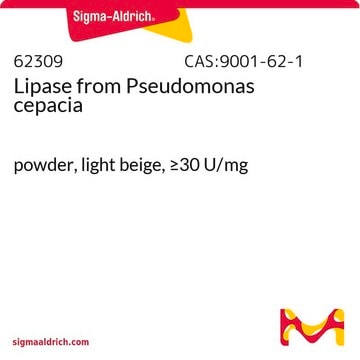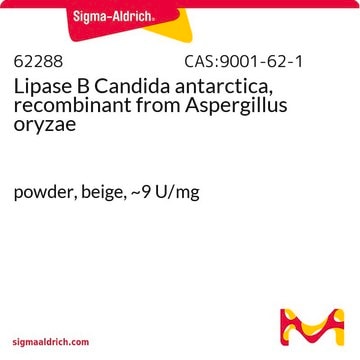L0777
Lipase aus Aspergillus oryzae
solution, ≥100,000 U/g, white, beige
Synonym(e):
AOL, Lipolase 100L
About This Item
Empfohlene Produkte
Biologische Quelle
Aspergillus sp. (Aspergillus oryzae)
Form
solution
Spezifische Aktivität
≥100,000 U/g
Lagerbedingungen
(Tightly closed. Dry)
Methode(n)
cell based assay: suitable
Farbe
beige
white
Lagertemp.
2-8°C
InChI
1S/C11H9N3O2.Na/c15-8-4-5-9(10(16)7-8)13-14-11-3-1-2-6-12-11;/h1-7,16H,(H,12,14);/q;+1/b13-9-;
InChIKey
QWZUIMCIEOCSJF-CHHCPSLASA-N
Suchen Sie nach ähnlichen Produkten? Aufrufen Leitfaden zum Produktvergleich
Allgemeine Beschreibung
Lipase is derived from Aspergillus oryzae by ammonium sulfate precipitation and chromatography.Lipases or triacylglycerol acyl hydrolases are a group of hydrolase enzymes that are usually found in humans and animals with monogastric stomachs. Lipase enzymes are generally formed in the pancreas and stomach where they aid in fat and lipids digestion.(2)
Anwendung
- as a control enzyme in activity assays
- as a component in lipolase stock solution for the hydrolysis experiments
- to incubate scaffolds for lipase-accelerated degradation experiments
- as the lipolytic enzyme standard to detect lipolytic enzymatic activity via chromogenic agar plates and zymography
Biochem./physiol. Wirkung
Angaben zur Herstellung
Rechtliche Hinweise
Antikörper
Enzym
Substrat
Ähnliches Produkt
Signalwort
Danger
H-Sätze
P-Sätze
Gefahreneinstufungen
Resp. Sens. 1
Lagerklassenschlüssel
11 - Combustible Solids
WGK
WGK 1
Flammpunkt (°F)
Not applicable
Flammpunkt (°C)
Not applicable
Persönliche Schutzausrüstung
Eyeshields, Gloves, type N95 (US)
Analysenzertifikate (COA)
Suchen Sie nach Analysenzertifikate (COA), indem Sie die Lot-/Chargennummer des Produkts eingeben. Lot- und Chargennummern sind auf dem Produktetikett hinter den Wörtern ‘Lot’ oder ‘Batch’ (Lot oder Charge) zu finden.
Besitzen Sie dieses Produkt bereits?
In der Dokumentenbibliothek finden Sie die Dokumentation zu den Produkten, die Sie kürzlich erworben haben.
Kunden haben sich ebenfalls angesehen
Unser Team von Wissenschaftlern verfügt über Erfahrung in allen Forschungsbereichen einschließlich Life Science, Materialwissenschaften, chemischer Synthese, Chromatographie, Analytik und vielen mehr..
Setzen Sie sich mit dem technischen Dienst in Verbindung.